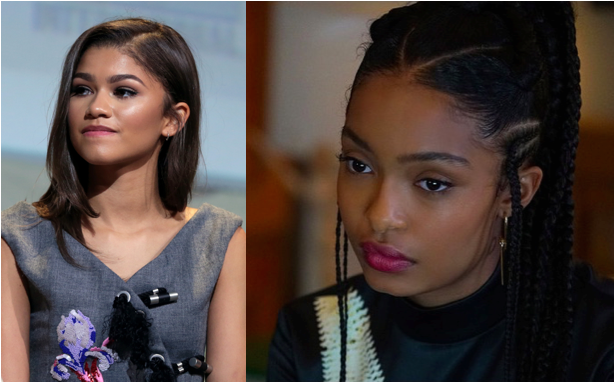When Will Colorism Fade into the Background?

Growing up as a black girl in the late 90s, role models were few and far between. Brandy, Nia Long and Gabrielle Union were just some of the few representations on TV and film, defining the 1990s and early 2000s, receiving a fair amount of work. However, these actresses fell into the same kind of role: a mean, aggressive, over sexualized woman, that is trying to take your man. In the movie Love & Basketball, Gabrielle Union portrayed Shawnee, the mean girl stealing someone's boyfriend. In Bring It On, Union acted the part of the sassy cheerleader that had no time for your nonsense.
With the recent broadcasting of the Emmy awards, debate sparked once again on representation in TV and film. The Emmy's delivered an awkward performance, “We Solved It!” with a few Saturday Night Live members and other famous celebrities, mocking how Hollywood has not quite “solved diversity.” That night, most of the awards were then given to straight white men.
All award shows have been trying to raise awareness in this new “woke” era, but that is clearly not being reflected in TV and films today.
According to TV Time, the world's largest TV tracking app, representation and diversity on TV is at an all time high. Others even argue that more roles are available for women of color.
Kinda, but not exactly all black women.
It has become quite clear that there are still disparities with women of color in TV and film; most notably younger and darker women of color
Right now, the faces of up and coming black women in the industry are Yara Shahidi, Kiersey Clemons, Logan Browning, Zendaya, Zoe Kravitz, Alexandra Shipp and others. These women are consistently starring in big blockbuster movies, lead TV show roles, endorsements, magazine covers and so on. The pattern? They are all from medium to light hues or simply biracial. "Colorism" is still very prevalent in Hollywood today.
According to the Oxford Dictionary, colorism, is defined as “a process that privileges light-skinned people of color over their darker counterparts in areas such as income, education, housing, and the marriage market," and this obviously bleeds into the entertainment industry as well and cannot seem to go away.
Spiderman rebooted just last year, and in a twist in appealing to a more diverse cast, had Zendaya as one of the main characters in the action film. This pattern of selective casting repeated with the release of Deadpool 2 this year, where Zazie Beetz starred in a main supporting role and, in the Ocean’s Eight reboot, where Rihanna played Nine Ball. The continuous pattern with Hollywood movies is clear: the lighter the better.
Dear White People is a TV show with a cast of mainly black actors. The cast consists of men and women of all shades, but this show falls into the same colorism trap. In terms of women being a romantic interest, the lighter women are considered more attractive, while the darker women are less desirable. Sam is biracial and the main character. She rejects two different men in love with her. The two men then go on to settle for darker women, which does not exactly send the best message in a show trying to debunk stereotypes and generalizations.
This pattern has been noticed by the stars themselves
Zendaya stated at the BeautyCon Festival this year in New York, that she recognizes her privilege and how the industry has continuously been harder for darker women and recognizing her own privilege in Hollywood today.
Keke Palmer, became one of the most successful child actresses in the early to mid 2000s. She had her own Nickelodeon show, Disney Original movie, and even a blooming music career. Growing into her adulthood, she has not been part of the mainstream.
Palmer has accepted various Broadway roles and TV show appearances, but she has not been able to reach the peak of success as her colleagues, like Zoe Kravitz or Yara Shahidi. In an interview with The Grio, she highlights having to work harder because of her darker complexion. Will she have the chance to truly star in a Hollywood blockbuster?
Image Credit: Flickr/Gage Skidmore
Viola Davis is one of the most successful actresses today and is a much darker hue. Davis leaped into the mainstream as Mrs. Miller in the 2008 movie, Doubt, starring alongside Meryl Streep. Her career then began to pick up, but she recognized that the majority of her success came much later.
In an interview with The Wrap, Davis says there continues to be a lack of choices for herself and darker skinned women. She further explains how Hollywood is still in the paper bag test era. If a women is darker than a paper bag, that somehow makes her less attractive.
Overall, there is not proper ethnic representation on TV or in film. According to the Center for The Study of Women in Television and Film, black female portrayals raised slightly from 14 percent in 2016 to 16 percent in 2017. However, of the top 100 films that grossed in 2017, only seven percent can be accounted for black female portrayals. Obviously, there is nothing wrong with being biracial or simply a lighter hue. However, it is quite apparent that being lighter is intrinsically more valuable than being darker.
With this sentiment continuing in TV and film, it is important to support shows promoting blackness of all shades including: How to Get Away With Murder, Insecure, Black Lightning, Orange is the New Black, and Queen Sugar. Giving viewership in diverse networks, films and TV shows will send the message that all shades should be included in casting.








